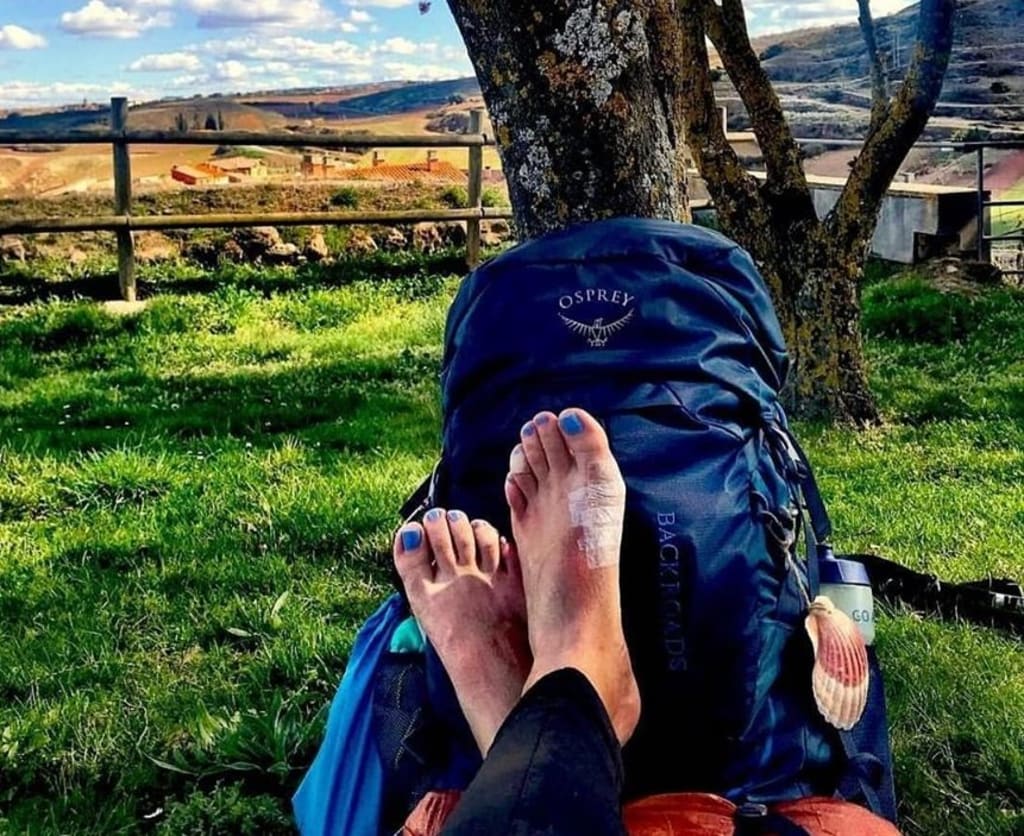The Dreaded Blisters. Caring For Your Feet On The Camino De Santiago
No Pain. No Glory. No Blisters. No Story.

It's time to talk about the dreaded blisters! The bane and fear of every Pilgrim on the Camino because who wants to suffer from blisters?
Yet, with a little preparation and knowledge, you can prepare and care for your feet to lower your chances of blistering, leaving you to enjoy the Camino de Santiago, free from foot pain.
Here are recommended tips for caring for your feet on the Camino de Santigo.
Wear The Right Type Of Shoes For The Camino You Choose
Wearing the correct walking shoes is possibly the number one way that you can protect against blisters. Knowing the type of trail that you will be walking on is paramount to understanding the type of walking shoes/boots you will need.
For example, the Camino Portuguese is very different from the Camino Primitivo. Many people choose to wear cross trainers or trail runners on the Camino Portuguese due to its flat nature and smooth trail. However, The Primitivo is a much more rugged trail with more likelihood of rain which will make for slippery terrain. More traditional walking boots may be needed.
Depending upon the time of year you walk the Camino, you will need to take into account the average weather and temperature. If you are walking during the summer months, your feet may overheat and swell so you will find that a lighter pair of walking shoes will benefit you. If you are walking during the rainy months, you may need boots that are waterproof.
Ensuring that your shoes are a good fit and that you break them in before your Camino is essential. New shoes on the Camino is likely to lead to one thing. Blisters.
You may also wish to use insoles to give you added cushion and protection.
Invest In Quality Hiking Socks
Your socks also play an important role in caring for your feet. I recommend that you use two pairs; an inner thin cotton sock and a merino wool outer sock. While expensive, Merino wool is proven to prevent excessive water build up from sweat, allowing your feet to breathe. By investing in good quality hiking socks, you´ll go a long way to ensuring your Camino is blister-free.
Avoid Pedicures & Clip Your Toenails Throughout The Camino
If you are female, you may wish to avoid pedicures in the lead up to your Camino. Pedicures remove the hard skin from your feet which will actually protect your feet on the Camino.
Also, ensure that you clip your toenails right back throughout the Camino. You'll be surprised how even a tiny extra length of toenail can cut into the surrounding toes or even cause your toenail to break.
Prepare A Foot Care Kit
As part of your Camino preparations, I recommend that you prepare a Foot Care Kit to include the following:-
Nail Clippers
Compeed Blister Plasters (see below)
Hiking Foot Cream
Vaseline
Normal Bandaids
Aloe Vera Gel
Antiseptic Cream
Daily use of hiking foot cream/vaseline before you begin your hike helps to prevent friction, the main cause of blisters.
Use Compeed
No two blister plasters are the same and Compeed Blister Plasters are by far the most superior plaster to treat blisters. Compeed packs can be expensive on the Camino so I recommend that you stock up before you go.
Keep Your Feet Clean & Dry
Keeping your feet clean and dry will go along way to help prevent blisters from forming. I recommend that you remove your socks and shoes regularly through your hiking day to give your feet the opportunity to cool off and dry.
There are many places where you can wash your feet along the way or you can take a little dip in the many streams along the Camino.
If Your Feet Do Blister
Resist the urge to pop the blister yourself. The fluid is there to protect your foot. Instead, pop a Compeed plaster over the blister which will allow you to continue walking without pain. If your blister is causing you severe pain or is too large, consider seeking medical attention at one of the many clinics in the towns and villages along the Way.
If you choose to pop the blister yourself, you end up with an infection. If the blister pops by itself, make sure to clean the area and apply antiseptic cream before applying a plaster to prevent infection taking hold.
Photo Credit Laura Kaer On Instagram
About the Creator
Samantha Wilson
Visit Samantha at www.samantha-wilson.com or follow on Facebook at www.facebook.com/samanthawilson or Instagram at www.instagram.com/samanthaemmawilson
Enjoyed the story? Support the Creator.
Subscribe for free to receive all their stories in your feed. You could also pledge your support or give them a one-off tip, letting them know you appreciate their work.






Comments
There are no comments for this story
Be the first to respond and start the conversation.